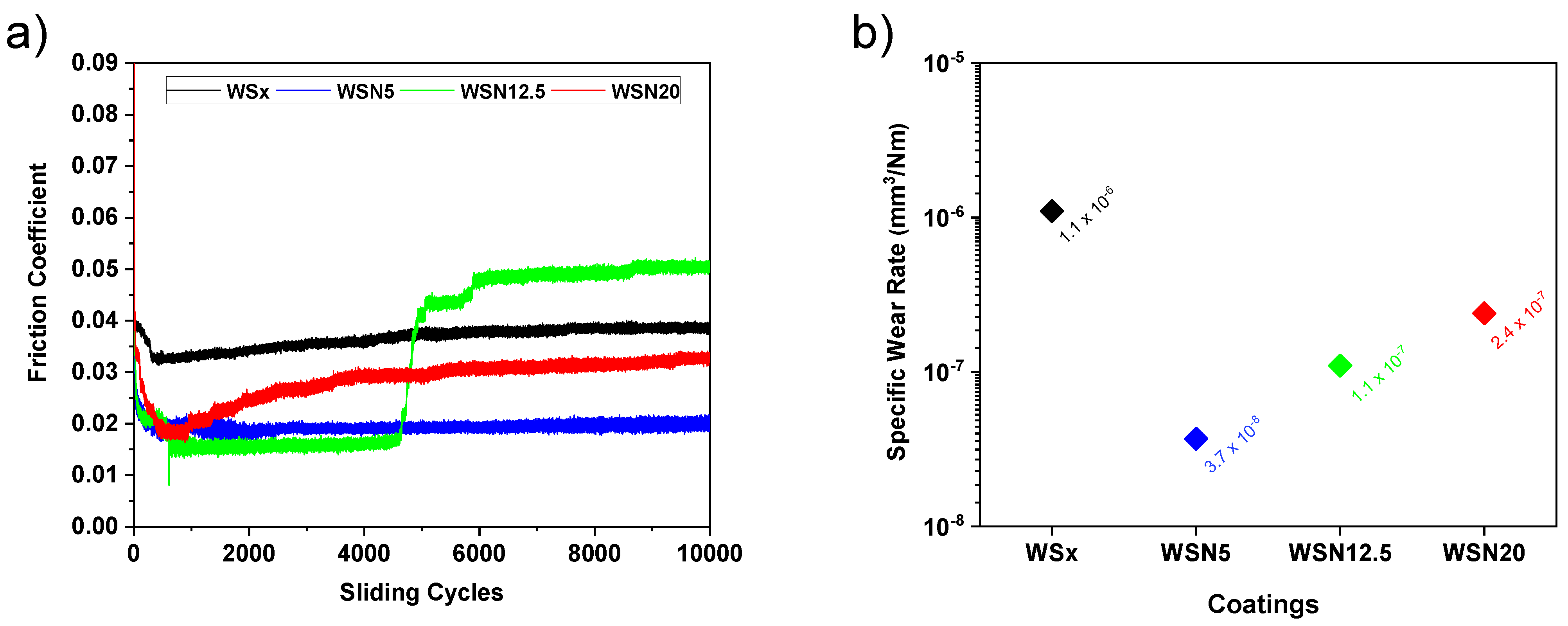Vacuum Tribological Properties of W-S-N Coatings Synthesized by Direct Current Magnetron Sputtering
Abstract
1. Introduction
2. Materials and Methods
3. Results and Discussion
4. Conclusions
Author Contributions
Funding
Institutional Review Board Statement
Informed Consent Statement
Data Availability Statement
Acknowledgments
Conflicts of Interest
References
- Vazirisereshk, M.R.; Martini, A.; Strubbe, D.A.; Baykara, M.Z. Solid lubrication with MoS2: A review. Lubricants 2019, 7, 57. [Google Scholar] [CrossRef]
- TBin Yaqub, T.; Vuchkov, T.; Evaristo, M.; Cavaleiro, A. DCMS Mo-Se-C solid lubricant coatings—Synthesis, structural, mechanical and tribological property investigation. Surf. Coat. Technol. 2019, 378, 124992. [Google Scholar] [CrossRef]
- Polcar, T.; Cavaleiro, A. Review on self-lubricant transition metal dichalcogenide nanocomposite coatings alloyed with carbon. Surf. Coat. Technol. 2011, 206, 686–695. [Google Scholar] [CrossRef]
- Voevodin, A.A.; O’Neill, J.P.; Zabinski, J.S. WC/DLC/WS2 nanocomposite coatings for aerospace tribology. Tribol. Lett. 1999, 6, 75–78. [Google Scholar] [CrossRef]
- Nossa, A.; Cavaleiro, A. The influence of the addition of C and N on the wear behaviour of W-S-C/N coatings. Surf. Coat. Technol. 2001, 142–144, 984–991. [Google Scholar] [CrossRef]
- Zhu, J.; Zeng, Q.; Zhang, B.; Yan, C.; He, W. Elevated-temperature super-lubrication performance analysis of dispersion-strengthened WSN coatings: Experimental research and first-principles calculation. Surf. Coat. Technol. 2021, 406, 126651. [Google Scholar] [CrossRef]
- Bin Yaqub, T.; Al-Rjoub, A.; Cavaleiro, A.; Fernandes, F. Exploring the industrial implementation of W-S-N coatings: A detailed study of the synthesis, compositional, structural, mechanical and multi-environment lubrication properties. J. Mater. Res. Technol. 2022, 18, 547–563. [Google Scholar] [CrossRef]


| Properties vs. Coatings | WSx | WSN5 | WSN12.5 | WSN20 | |
|---|---|---|---|---|---|
| Composition (at.%) | W | 40.0 | 39.0 | 38.1 | 35.6 |
| S | 59.0 | 45.6 | 37.9 | 38.1 | |
| N | - | 14.6 | 23.0 | 25.5 | |
| Hardness (GPa) | 3.7 | 6.6 | 8.0 | 7.2 | |
| Friction Coefficients | Room Temperature (humid air) | 0.09 | 0.15 | 0.09 | 0.11 |
| 200 °C | 0.04 | 0.05 | 0.02 | 0.02 | |
| Dry Nitrogen | 0.02 | 0.03 | 0.03 | 0.04 | |
| Specific Wear Rates (mm3/Nm) | Room Temperature (humid air) | 4.10 × 10−7 | 1.00 × 10−7 | 7.20 × 10−8 | 6.10 × 10−7 |
| 200 °C | 3.00 × 10−7 | 1.30 × 10−7 | 7.10× 10−8 | 1.60 × 10−7 | |
| Dry Nitrogen | 5.00 × 10−8 | 9.30 × 10−9 | 1.20 × 10−8 | 2.30 × 10−8 | |
Publisher’s Note: MDPI stays neutral with regard to jurisdictional claims in published maps and institutional affiliations. |
© 2022 by the authors. Licensee MDPI, Basel, Switzerland. This article is an open access article distributed under the terms and conditions of the Creative Commons Attribution (CC BY) license (https://creativecommons.org/licenses/by/4.0/).
Share and Cite
Yaqub, T.B.; Yaqoob, K.; Mukhtar, A.; Fernandes, F.; Bondarev, A.; Ferreira, F.; Al-Rjoub, A.; Cavaleiro, A. Vacuum Tribological Properties of W-S-N Coatings Synthesized by Direct Current Magnetron Sputtering. Coatings 2022, 12, 1646. https://doi.org/10.3390/coatings12111646
Yaqub TB, Yaqoob K, Mukhtar A, Fernandes F, Bondarev A, Ferreira F, Al-Rjoub A, Cavaleiro A. Vacuum Tribological Properties of W-S-N Coatings Synthesized by Direct Current Magnetron Sputtering. Coatings. 2022; 12(11):1646. https://doi.org/10.3390/coatings12111646
Chicago/Turabian StyleYaqub, Talha Bin, Khuram Yaqoob, Amir Mukhtar, Filipe Fernandes, Andrey Bondarev, Fabio Ferreira, Abbas Al-Rjoub, and Albano Cavaleiro. 2022. "Vacuum Tribological Properties of W-S-N Coatings Synthesized by Direct Current Magnetron Sputtering" Coatings 12, no. 11: 1646. https://doi.org/10.3390/coatings12111646
APA StyleYaqub, T. B., Yaqoob, K., Mukhtar, A., Fernandes, F., Bondarev, A., Ferreira, F., Al-Rjoub, A., & Cavaleiro, A. (2022). Vacuum Tribological Properties of W-S-N Coatings Synthesized by Direct Current Magnetron Sputtering. Coatings, 12(11), 1646. https://doi.org/10.3390/coatings12111646









